Situated approximately 27 million light-years away from Earth, M51, commonly known as the Whirlpool Galaxy, is one of the most classic and well-known examples of the spiral galaxy type. Located in the constellation Canes Venatici, Whirlpool Galaxy has captivated the attention of astronomers, professionals, and enthusiasts alike due to its clear and distinguishable structure, coupled with the intriguing interaction it has with its neighboring satellite galaxy, NGC 5195 or M51b. M51 is probably the first galaxy you picture when you think of a spiral, owing to its ubiquitous portrayal in media and science textbooks around the world.
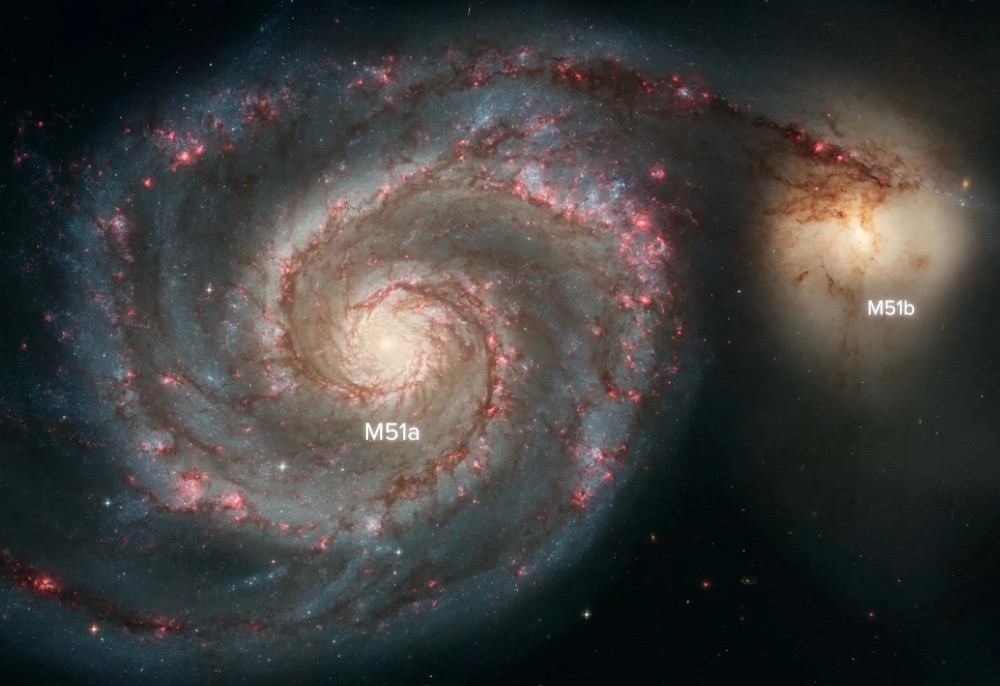
M51a was the first galaxy discovered to be a spiral, though this took over 70 years after it was initially spotted through Charles Messier’s telescope in 1773. The discovery of M51’s spiral nature seeded the idea that such objects could be distinct and separate “island universes,” a term that would later evolve into what we now understand as galaxies. This wasn’t overnight; for decades, astronomers described these “spiral nebulae” as likely just nebulous clouds within our Milky Way, but eventually the idea took hold that there were “island universes” besides our own. This paradigm shift had a cascading effect on astronomical thought. If our universe were populated by myriad galaxies, its scale would be vastly larger than ever imagined. This, in turn, became one of the cornerstone observations leading to the formulation of the Big Bang theory, suggesting that the universe had an origin point and has been expanding ever since.
Contents in this article:
What is M51?
M51 is classified as a classic “grand-design” unbarred spiral galaxy. This means it has prominent and well-defined spiral arms. These arms, composed of stars, gas, and dust, wind their way from the galaxy’s central core, creating a whirlpool-like appearance, which is the source of its popular name. Its core is also circular in appearance, lacking an elongated “bar” of stars and material like the center of our own Milky Way Galaxy.
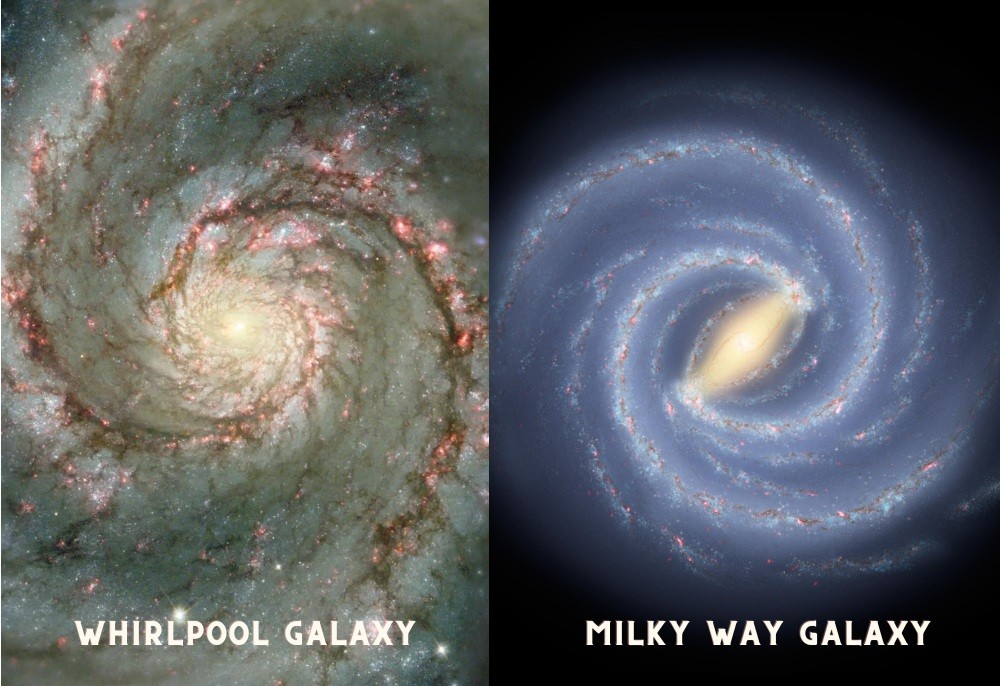
M51 itself is only about ¾ of the diameter of our own galaxy, but it is similar in mass and intrinsic brightness owing to its densely-populated spiral arms, which are home to more star-forming regions and are wound more tightly than those of the Milky Way.
Our fantastic view of M51’s spiral structure is only possible because M51 happens to be tilted so that we view it from directly above the plane of the spiral arms at a nearly 90-degree angle to its disk. Other spiral galaxies, like the Andromeda Galaxy, for instance, tend to appear at more of an angle from our perspective; this makes them contrast more against the sky and easier to spot, but it’s harder to recognize their grand spiral arms at first. The dust lanes of some spirals, such as those of edge-on M104, the Sombrero Galaxy, can make it hard to even tell if the galaxy is a spiral at all or a more simplistic lenticular galaxy merely encased in a dark, dusty belt.
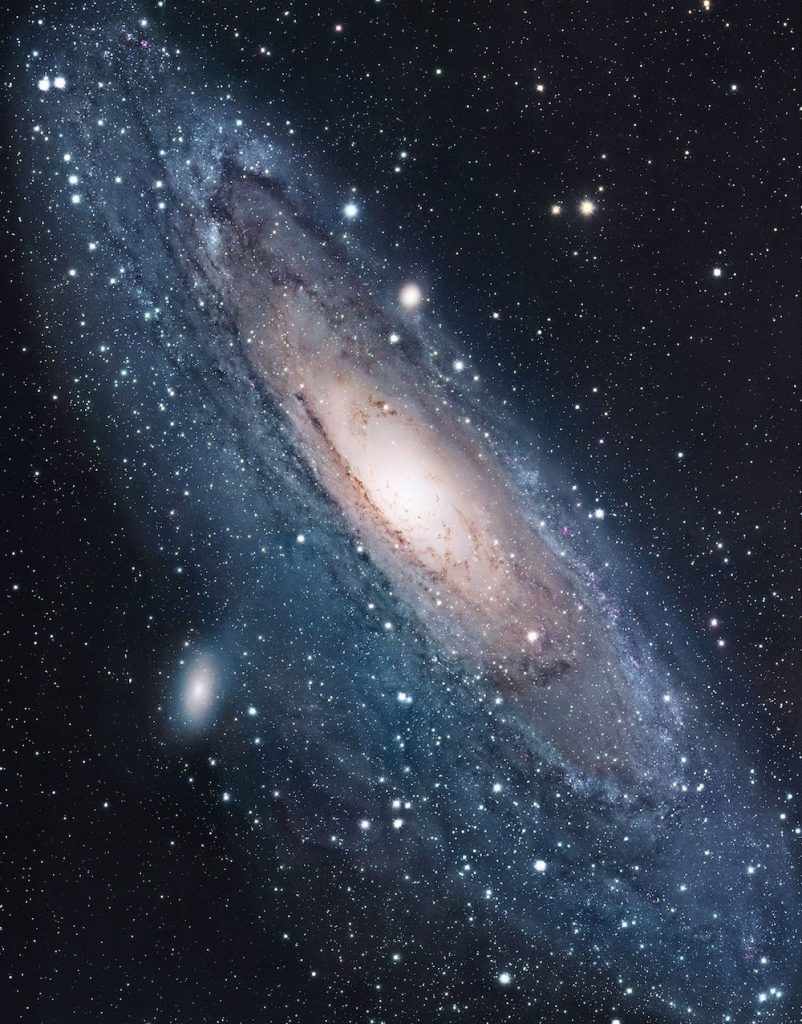
The spiral arms in M51, like those of our own galaxy, are sites of active star formation, where bright blue clusters of young stars ionize gas clouds like our own familiar Orion Nebula. The pink-red glowing regions corresponding to emission nebulae seen in long-exposure images of the galaxy are known as H-II regions; the bluer star clouds are also striking in photographs.
M51 and NGC 5195 (M51b)
One of the most striking and immediately apparent features of Whirlpool galaxy is its interaction with a smaller companion galaxy, NGC 5195. This smaller body appears to be “tugging” on one of the Whirlpool Galaxy’s arms, creating a bridge-like connection of stars and interstellar material between the two galaxies. It’s this gravitational dance that has greatly influenced M51’s current shape and structure.
The bridge of material and the distortion of M51’s arms are the result of tidal forces, much like the gravitational forces the Moon exerts on Earth’s seas. In galactic terms, these forces can pull out streams of stars and gas, leading to the formation of tidal tails or bridges. NGC 5195, due to its close encounters, has played a pivotal role in shaping M51’s appearance through these forces.
The interaction between M51 and NGC 5195 is not a recent event. Astronomers believe that these two galaxies have had multiple close encounters over the past few hundred million years. NGC 5195’s current position, behind M51 from our vantage point, suggests it has moved through and past the Whirlpool Galaxy. This passage has compressed the gas in M51, triggering regions of intense star birth and causing its spiral arms to brighten. This makes M51 one of the brighter face-on spirals as seen from Earth; many others have dim outer regions owing to lower star-forming activity.
Where is M51, and How Do I Find The Whirlpool Galaxy?
Whirlpool galaxy resides in the constellation Canes Venatici, the Hunting Dogs. While this constellation might not be as familiar as its neighboring Ursa Major, its proximity provides a great starting point for our search. The M51 itself is basically invisible to the naked eye. Skilled observers under extremely dark skies can spot it as a fuzzy patch, but in practice, it’s confined to the realm of binoculars and telescopes. M51 is usually fairly easy to observe with ordinary binoculars or a small telescope, even from a city, owing to its brightness and fairly small angular size.
There are two well-established routes via which you can “star-hop” to M51. The first is easier under very light-polluted skies but less accurate. Start by identifying the Big Dipper’s handle. Move from the end of the handle (the star Alkaid) towards the bowl. Just below the last two stars of the handle (Mizar and Alcor), if you extend an imaginary line, you’ll find a relatively bright star. This is Cor Caroli, the brightest star in Canes Venatici. From Cor Caroli, look a little to the east and slightly north. M51 is situated about halfway between Cor Caroli and the end of the Big Dipper’s handle.
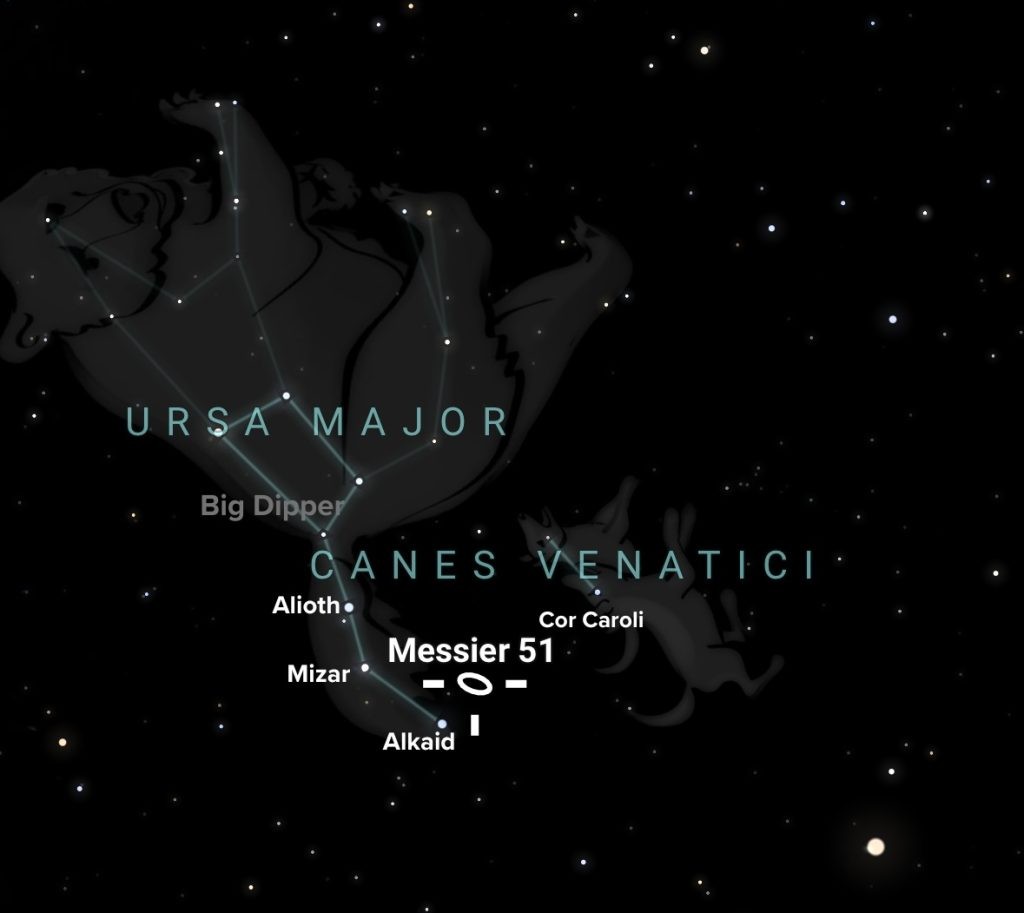
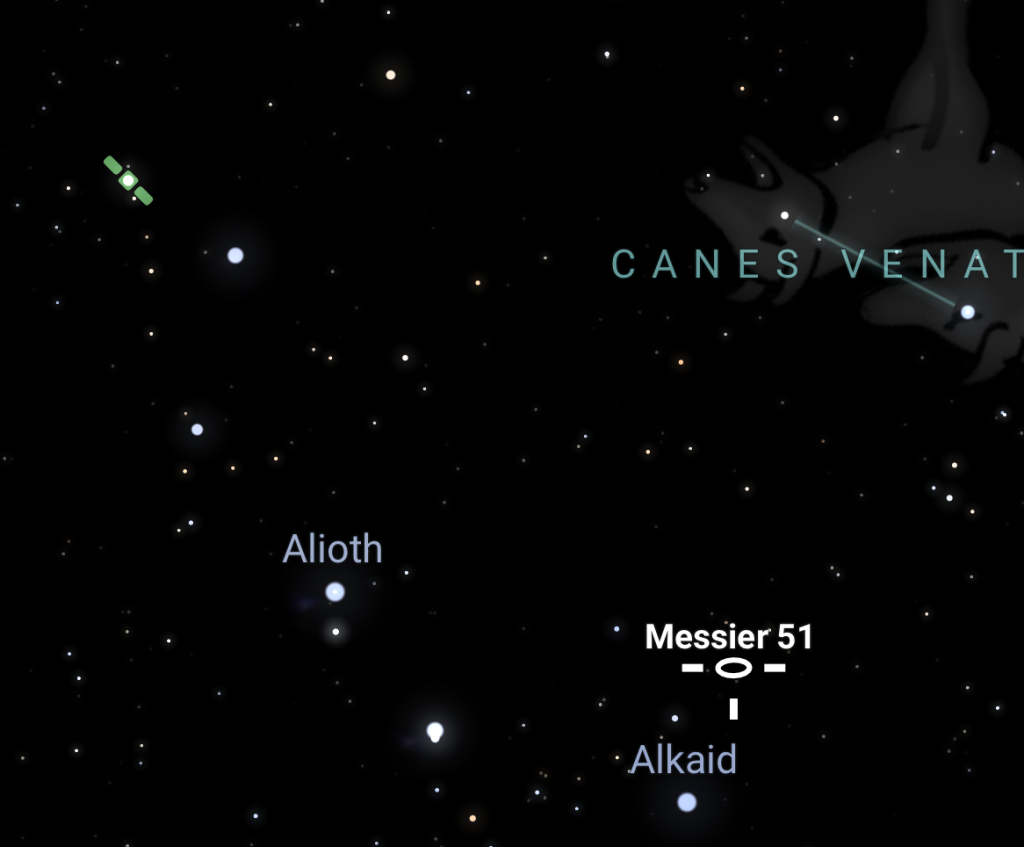
The more precise method is to start at Alkaid, then use two stars in Canes Venatici. Moving west of Alkaid, you’ll encounter two notable stars: 24 Canum Venaticorum (24 CVn) and 21 Canum Venaticorum (21 CVn). While they are not as bright as the stars of the Big Dipper, they are recognizable in a relatively sparse area of the sky at magnitudes 4.5 and 5, respectively, visible with the naked eye under decent conditions and easy to spot as bluish points in a finder scope or binoculars. These stars will guide you closer to M51.
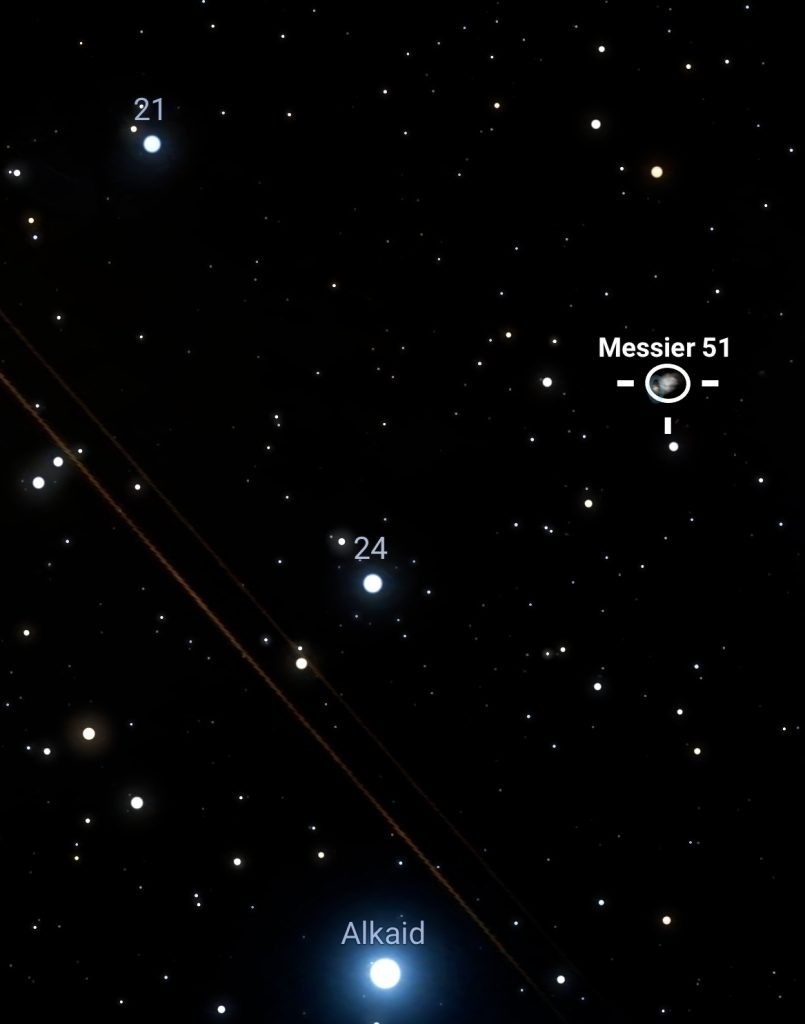
Try to visualize an imaginary line formed by Alkaid, 24 CVn, and 21 CVn. M51 lies below 24 CVN, directly away from the Dipper’s bowl, or in an imaginary triangle with 24 and 21 CVn. A slightly fainter orange star, HD 116957, at sixth magnitude, is adjacent to a typical low-power view containing M51, while several seventh-magnitude stars surround the galaxy through binoculars or a telescope.
What does the M51 Look Like Through a Telescope?
The clarity with which you’ll observe the Whirlpool Galaxy through a telescope greatly depends on the quality of your night sky. Light pollution from city lights can significantly hamper your view. For the best experience, try to observe from a location away from city lights on a moonless night. Under light-polluted skies, it can be hard to see M51 at all, and even a powerful telescope will not reveal structure in the galaxy besides the existence of companion galaxy NGC 5195. Clear, dark skies are needed to view the faint, wispy spiral arms and the details within them.
Using regular 30- to 50-mm binoculars, the M51 will appear as a faint, blurry patch of light that appears slightly elongated to the discerning eye. NGC 5195, the smaller galaxy interacting with M51, might be challenging to make out as a separate object at magnifications below 20x. Small telescopes reveal little extra detail but do allow one to more clearly distinguish NGC 5195 at higher magnifications. Larger apertures make the cores of both galaxies appear brighter and add hints of an outer disk or glow around the center of M51; under a semi-dark sky, a 4” or 5” telescope can show you that something encases the bright glow of the core, though exactly what it is is unclear.
A 6-8” telescope begins to reveal the spiral arms of the M51 to a skilled observer under a decent sky. However, it’s hard to really describe the view you see as a spiral; the fuzzy, dim halo encircling the main galaxy dims rapidly at higher magnifications owing to its diffuse nature. A 10–12” telescope at fairly high power (100–200x) reveals the arms as a faint, ethereal glow; at low power, the gaps between the arms blur together into a halo of light around the core of the galaxy, overlapping with its companion.
A 14- to 18-inch telescope is ideal for really seeing the spiral arms of the Whirlpool Galaxy. Through a telescope this size, you can also see the bridge of matter connecting the main galaxy to NGC 5195 and even a dark lane intersecting the companion galaxy. H-II regions in the M51’s spiral arms become more apparent with increasing aperture, too. Larger telescopes make the spiral arms stand out more clearly against the background, reveal more H-II regions, and resolve other fine details; a 30” telescope even shows a slightly yellow tinge to the bright core regions of the galaxy under good viewing conditions.
